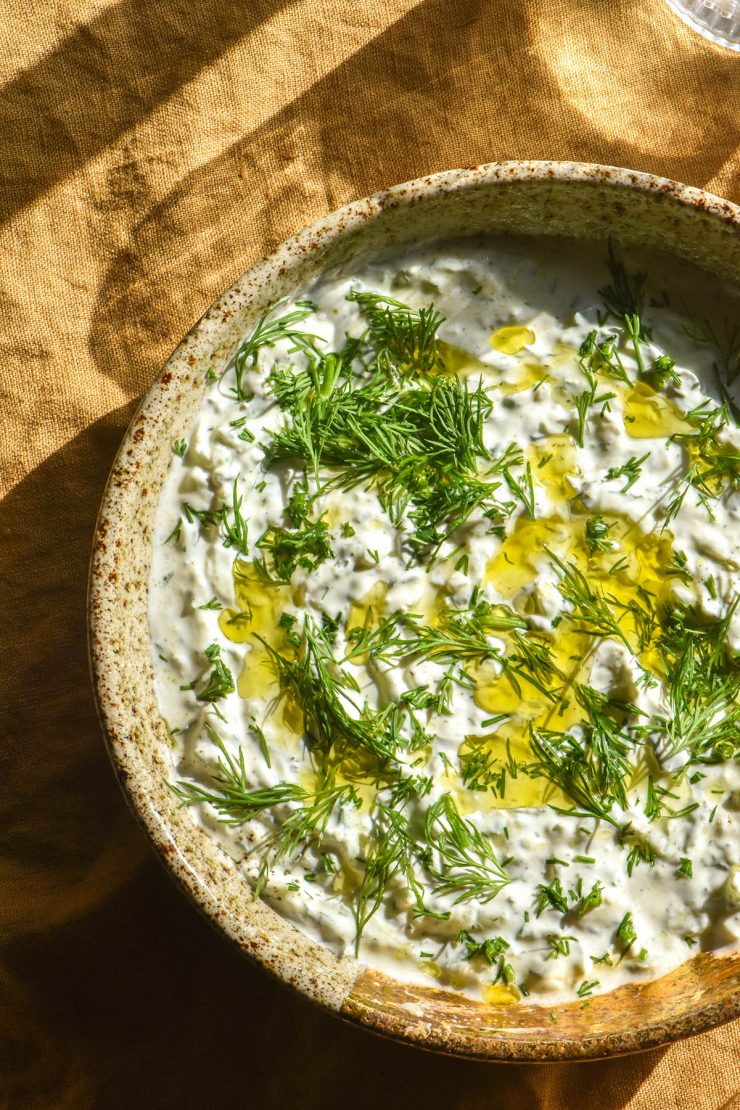
I am absolutely a dip girl; almost all of my lazy girl dinners feature a dip component of some sort. Low FODMAP dips and low FODMAP sauces can be hard to come by, which is why I figured it’s about time I post a low FODMAP tzatziki recipe.
Low FODMAP tzatziki recipe
This easy tzatziki dip uses a simple Greek yoghurt base. In learning about fermentation and lactose for my impending lactose free sour cream recipe, I have learnt that acidic dairy products are often lower in lactose. However, I like to buy Jalna lactose free Greek yoghurt for peace of mind/stomach.
Next, we add some salted and drained grated cucumber. This adds texture and a subtle cooling flavour without adding too much liquid. Dill rounds out the flavour profile and also helps thicken the dip over time.
Finally, the the most important element: low FODMAP pickled garlic. Monash has recently added a threshold for pickled garlic – 3g is a low FODMAP serve and it remains low FODMAP until it exceeds servings of 29g. This makes it a fantastic way to add that delicious garlic flavour into your tzatziki.
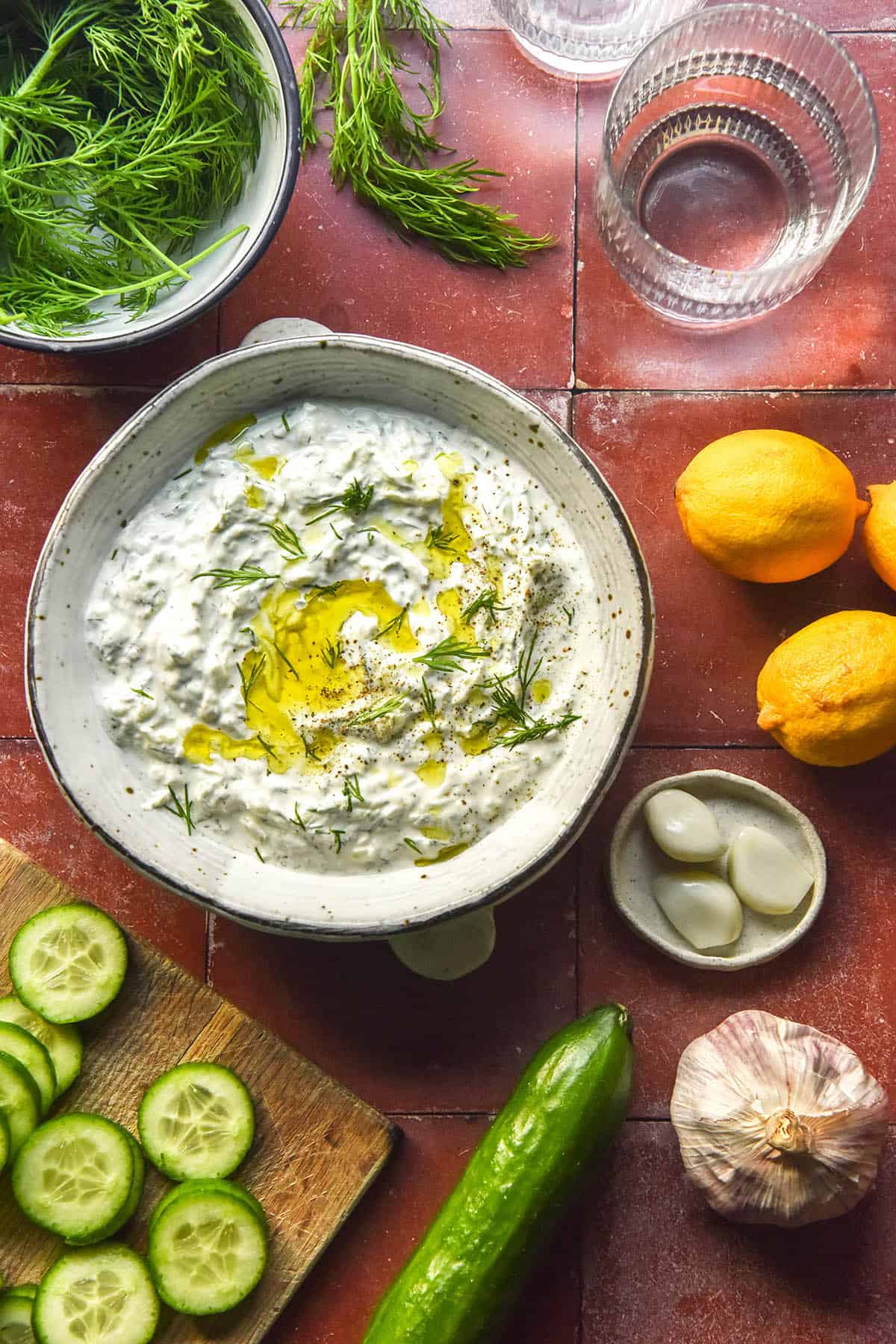
Pickled garlic notes
If you are new to the idea of pickled garlic, I’m sure you have questions. Although I didn’t realise that pickled onion (large onions) have had a low FODMAP threshold of 60g for a few years now, this development might be a surprise to some.
Monash theorise that, like canned beans, the FODMAP content leeches out into the brine. This is how pickled garlic has a FODMAP threshold while regular garlic does not.
Pickled garlic is low FODMAP in 3g serves and remains low FODMAP in up to 29g serves. Beyond that, it contains moderate levels of fructose.
Making your own pickled garlic is an absolutely fantastic way to get garlic in on the low FODMAP diet. Having tested store bought as well as homemade, I can say that homemade is infinitely better (words don’t do it justice). It tastes just like garlic only pickled and crunchy. I have found store bought to have a tinny, neutral flavour and a squishy texture.
Because I like homemade pickled garlic so much more than store bought, I have a recipe here.
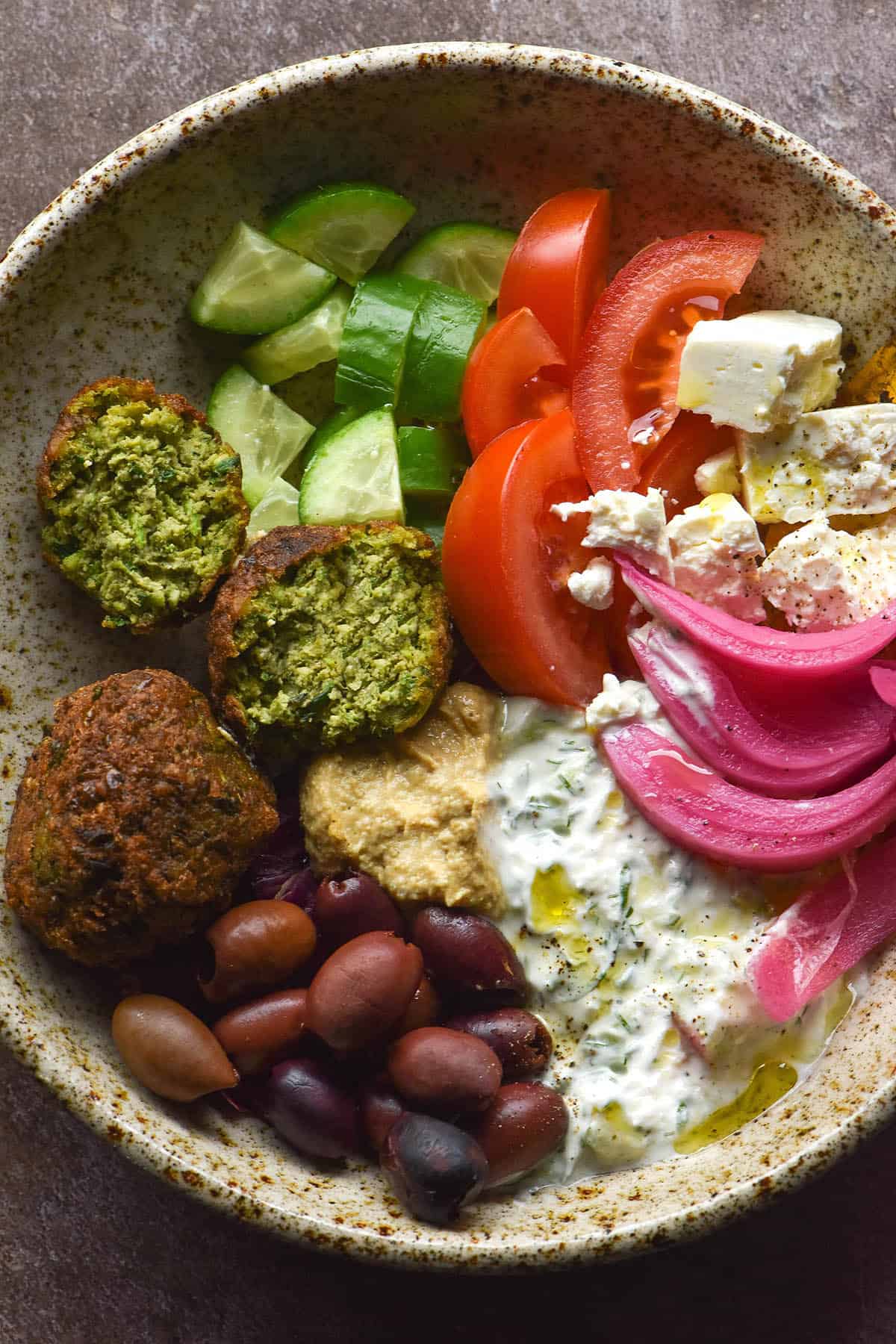
FODMAP notes
I have discussed the pickled garlic above and the yoghurt below, but I will include them here just for efficiency of information. These thresholds are current as of June 2025.
Pickled garlic is low FODMAP in 3g serves and remains low FODMAP in up to 29g serves. Beyond that, it contains moderate levels of fructose.
Greek yoghurt is low FODMAP in 23g serves. In 93g serves, it contains moderate amounts of lactose. I use Jalna lactose free Greek yoghurt to avoid any lactose constraints.
Monash don’t have an entry for lactose free Greek yoghurt specifically, but they do for lactose free yoghurt – it remains low FODMAP in serves of up to 500g. If you don’t use lactose free Greek yoghurt, a serving will be significantly smaller.
On the flipside, only the cucumber constrains how many servings you can eat of the lactose free version. Lactose free yoghurt should contain little lactose and all the remaining ingredients remain well under low FODMAP thresholds. A lactose free version needs to serve 4 people to account for the fructose in the cucumber.
Lebanese cucumbers are low FODMAP in 75g serves and in 97g serves they contain moderate amounts of fructose. Continental cucumbers are low FODMAP in 75-132g serves. In excess of that, they contain moderate fructose.
This recipe contains 300g of cucumber in total. Keep in mind other fructose containing ingredients you might be serving it with.
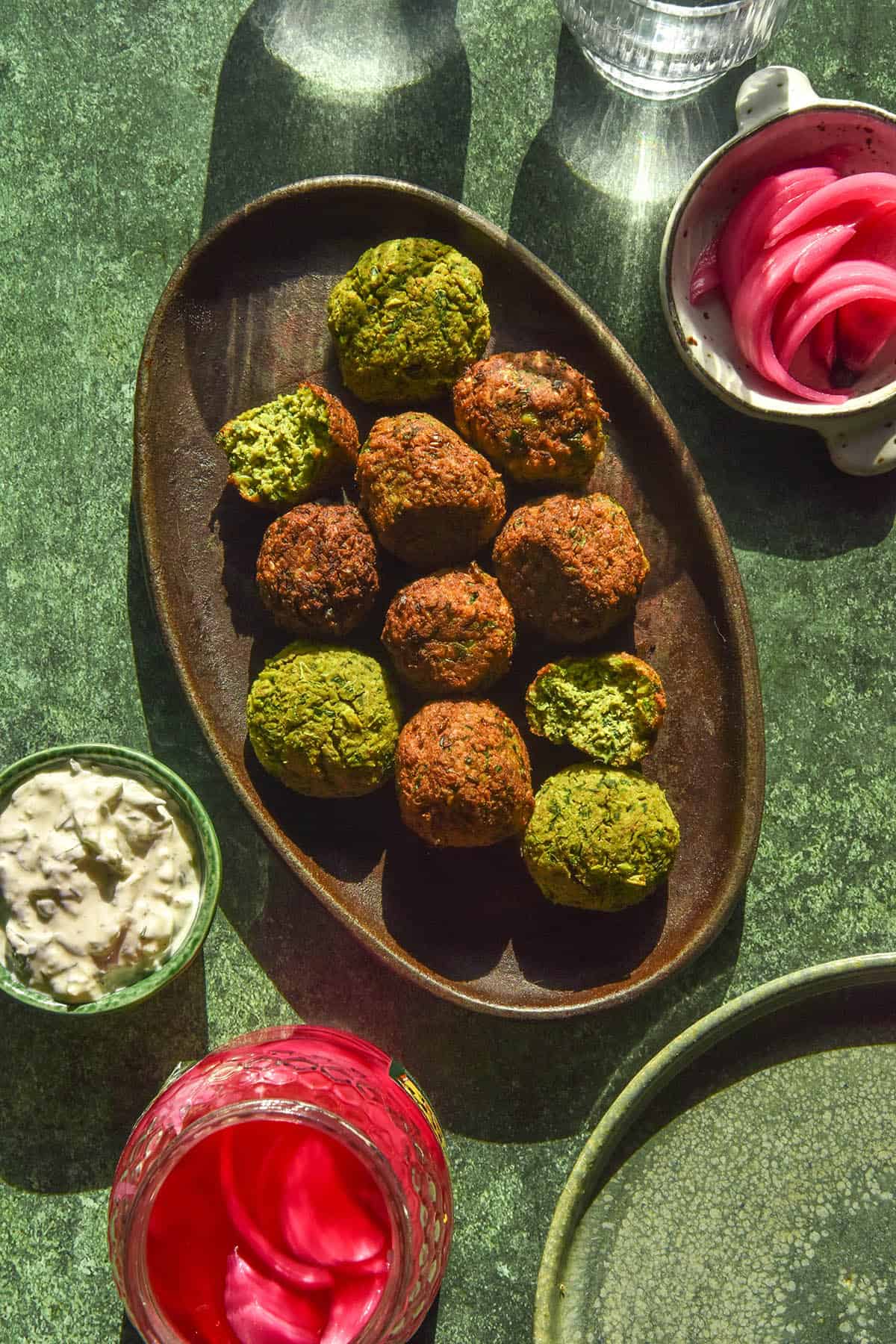
Notes on the yoghurt
Greek yoghurt has been fermented and strained, whereas Greek style yoghurt has been fermented but has not been strained.
Bacteria consume lactose in yoghurt during the fermentation stage which helps to lower the lactose content. Straining, however, removes even more of the lactose content. This makes Greek yoghurt lower in lactose than Greek style or regular yoghurt. Still, real Greek yoghurt is only low FODMAP in 23g serves according to Monash. In 93g serves, it contains moderate amounts of lactose.
In Australia, we are lucky enough to have lactose free Greek yoghurt on the shelves (Jalna brand). It is perfectly thick, truly Greek yoghurt.
The thickness is not just important for lactose concerns – it is key to achieving a thick and delicious low FODMAP tzatziki. Because we’re adding cucumber (a very liquid heavy ingredient) we need a nice thick yoghurt to withstand the added liquid.
Many lactose free brands on the shelves are super thin and watery. If you’re Australian based, I highly recommend Jalna or Chobani Fit. Not sponsored (I wish) just a genuinely good brands that I use regularly.
Chobani Fit (natural Greek yoghurt, in the large tub) don’t advertise it, but Chobani Fit (the Fit range specifically) has added lactase to make the range lactose free or low lactose.
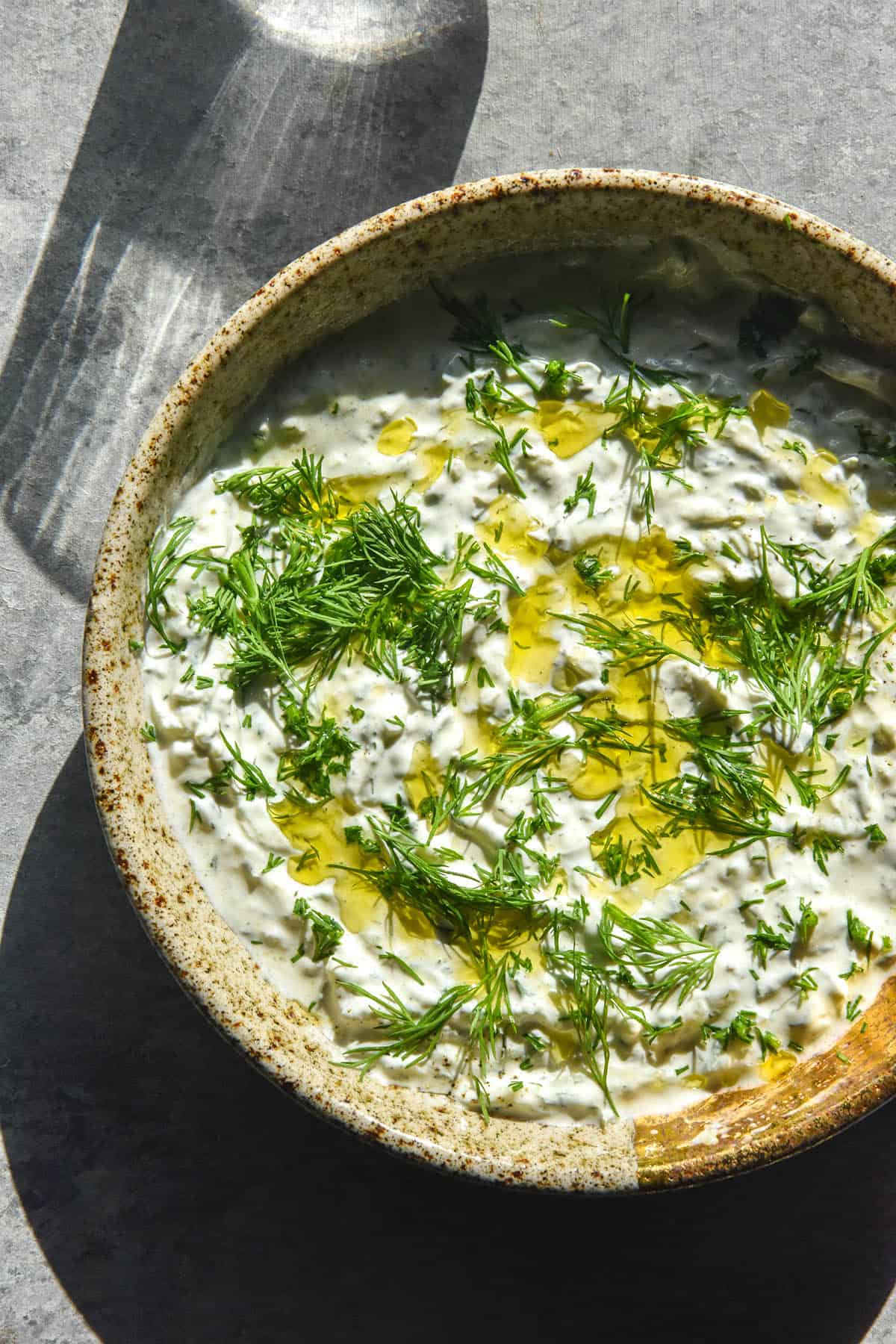
Can I make low FODMAP tzatziki with vegan yoghurt?
Although I haven’t tried it, I am confident you can make this into a low FODMAP vegan tzatziki.
Monash has listed coconut yoghurt as a low FODMAP ingredient in 149g serves. In 200g serves, they say it contains moderate amounts of sorbitol. This recipe uses 500g yoghurt in total. This keeps it under 149g yoghurt for four people.
In choosing a coconut yoghurt, there are a few things to look out for. Firstly, it needs to be a natural, unsweetened variety (of course). Nobody wants a sugary tzatziki.
Secondly, choose a brand with a lovely thick texture. Runny yoghurt makes for runny tzatziki, so texture matters here. I recently bought Chobani Greek style for a different recipe and was pleasantly surprised with the thickness and ingredient list, but choose whatever you know and enjoy (as long as it is thick).
Finally, keep an eye out on the ingredients list for any high FODMAP ingredients. Coconut yoghurt generally contains fillers and thickeners to give it the right texture. High FODMAP ingredients include chicory and inulin, which are often used as thickeners.

Recipe tips
- Thick Greek yoghurt is important to ensure the tzatziki remains thick after the cucumbers are added.
- To that end: thoroughly strained grated cucumber is key to ensuring you don’t end up with a waterlogged tzatziki.
- Very finely chopped dill is worth the time investment, I promise. Big chunks of dill in your tzatziki are annoying to eat and ruin the texture. Take the time to finely chop the dill and you will be rewarded.
- Same goes for the pickled garlic cloves. Very finely crushed is not only better for texture but it will also help distribute the garlic flavour for maximum impact.
- I highly recommend making your own pickled garlic – the flavour is so much better than store bought that I can’t even put it into words.
- Lebanese cucumbers are recommended for making tzatziki. This is because they have soft skins, a firm flesh and minimal seeds. Lebanese cucumbers are also called Persian cucumbers in some places.
- You can use finely chopped mint to taste if you don’t want to use dill for whatever reason.
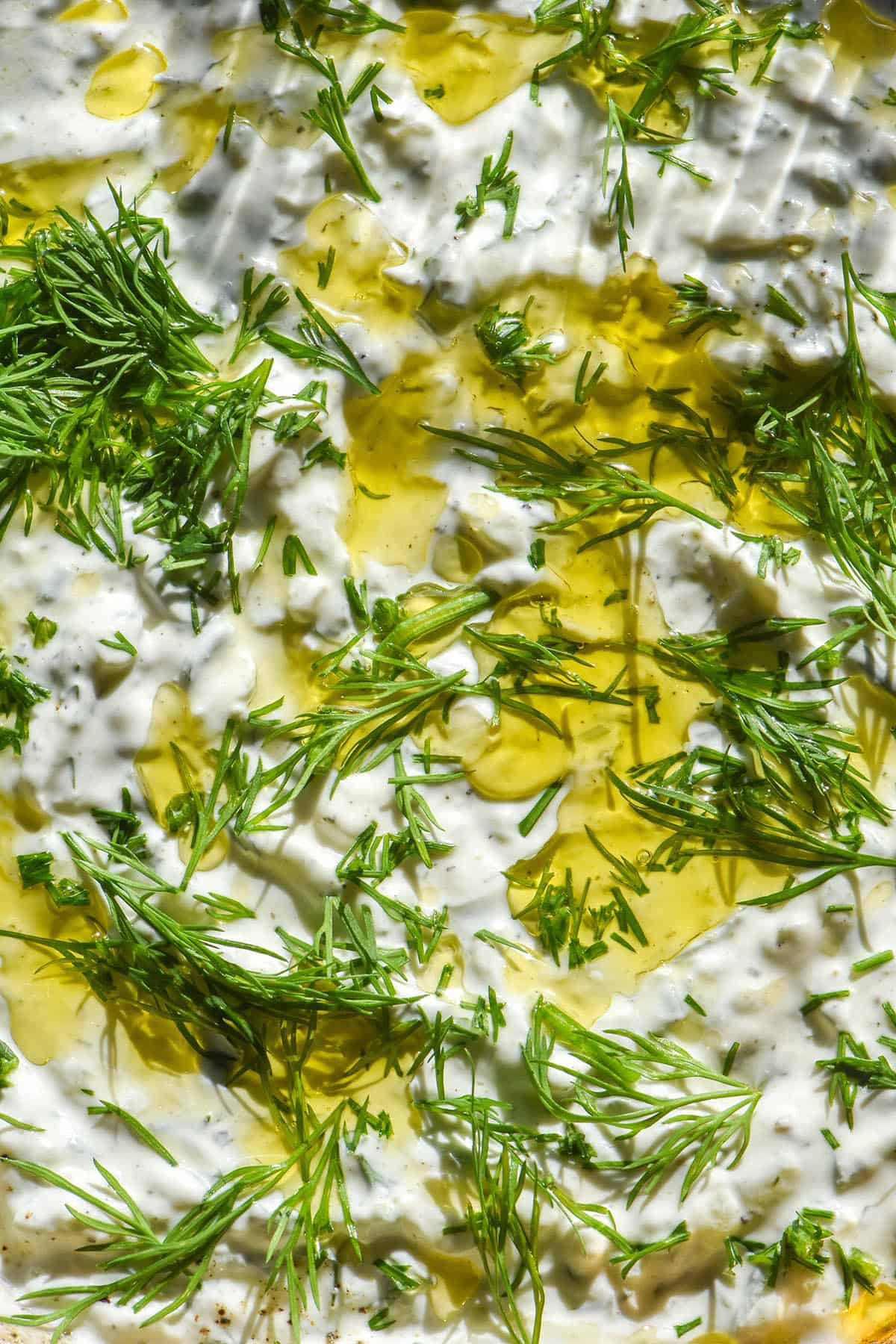
What low FODMAP foods can I serve with this tzatziki?
What you serve with your tzatziki depends a little on what you end up adding to your tzatziki. If you use a lactose-full Greek yoghurt, you will need to ensure whatever you serve your tzatziki with is very low lactose or lactose free. You will also only be
If you make your tzatziki with lactose free yoghurt, this constraint doesn’t apply. You do, however, need to be a little mindful of serving it with high fructose foods due to the fructose content of the cucumber and the pickled garlic. This is of particular importance if you eat a full serve (1/2 cup or 125g serves).
High fructose foods that you’d find paired with tzatziki include tomatoes, large pickled onion (which yes, has a low FODMAP threshold of 60g), capsicums and eggplants, among others. Of course, always assess your own tolerance and do what works for you.
Some suggestions:
- Salad greens, a low FODMAP protein and a gluten free wrap (buckwheat, teff, quinoa or regular)
- Grilled meats if you are not vegetarian
- Oven baked crispy potatoes
- Low FODMAP falafel
- Crudités of low FODMAP/fructose vegetables (carrots, radishes, crackers)
More low FODMAP dip and sauce recipes
- Low FODMAP aioli
- Low FODMAP garlic dip
- Low FODMAP vegan Caesar salad dressing
- Low FODMAP tofu hummus
- Low FODMAP Green Goddess dressing

Low FODMAP tzatziki recipe
Ingredients
- 300 g Lebanese cucumber grated on the largest side of your box grater
- ¼ teaspoon fine salt
- 500 g lactose free Greek yoghurt thick, full fat, see notes
- 10 g+ finely chopped dill to your tastes
- 12-20 g+ pickled garlic see notes, and see notes for link to recipe
- 10-20 ml extra virgin olive oil to your tastes
- 2 + teaspoons lemon juice or vinegar of choice to your tastes
- Fine salt and freshly cracked pepper to your tastes
Instructions
- Grate the cucumber and place into a sieve over the sink. Sprinkle over the fine salt, then begin to squeeze out the excess moisture. Do this really thoroughly – removing this excess liquid now is what will give you a lovely thick tzatziki. My cucumber weighed 150g after squeezing, so I removed half its weight in liquid.
- Spoon the yogurt into a medium mixing bowl and add the remaining ingredients. The best way to achieve your ultimate tzatziki is to add everything to your tastes. Continue adding and tasting until you reach your desired flavour.
- Place the tzatziki into the fridge for at least an hour before serving. Thin yoghurt will not thicken up, so ensure you choose a super thick, truly Greek variety to begin with.
- Leftovers keep well in the fridge for a week.
Notes
- Lebanese cucumber is chosen for its thin skin, firm flesh and lack of large seeds. I recommend using Lebanese cucumber here.
- Draining the cucumber thoroughly should be top priority. This is an easy recipe and draining the cucumber is the only part of it that takes a bit of time. I highly recommend doing it properly and thoroughly.
- A thin and runny yoghurt will not magically thicken into a dip like consistency. Make sure you choose a thick Greek yoghurt (not Greek style or natural) for a thick tzatziki. I recommend Jalna lactose free yoghurt or plain Chobani Fit (specifically Fit as it is lactose free) in Australia.
- A low FODMAP serve of this tzatziki is 125g if you use lactose free Greek yoghurt or only 21g if you use regular Greek yoghurt.
- The aforementioned lactose free Greek yoghurts are easily accessible in Australian supermarkets.
- Pickled garlic is a new low FODMAP ingredient (see the FODMAP notes in the body of the post for more information). I have a recipe for it here – homemade is so much better than store bought.
- Pickled garlic is low FODMAP in 3g serves and remains so in serves of up to 29g per person. You can experiment with your tolerances and see how much works for you. Pickled garlic is less potent than fresh garlic, which is why the recipe uses more. If you plan to use fresh garlic (for those who tolerate it) add it to taste.

No Comments